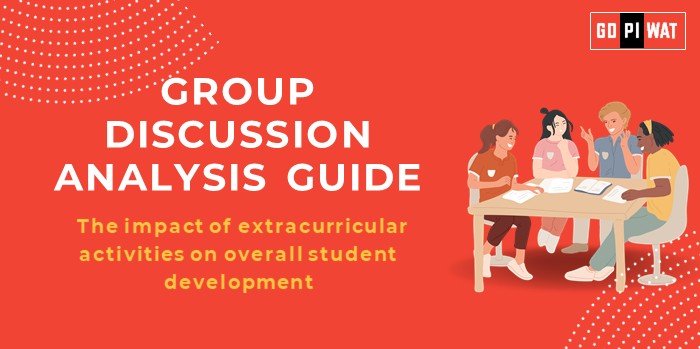📋 The Impact of Extracurricular Activities on Overall Student Development
🌐 Group Discussion (GD) Analysis Guide
💡 Introduction to the Topic
Opening Context: “Extracurricular activities are critical in shaping well-rounded individuals, offering students opportunities to explore talents, build social skills, and enhance their academic experience. For B-school aspirants, understanding their role in holistic development is crucial.”
Topic Background: “The integration of extracurricular activities into education has been widely recognized since the early 20th century. Today, activities ranging from sports and arts to volunteering and leadership programs significantly contribute to student success. With rising awareness about emotional intelligence and skill diversification, these activities are now seen as indispensable to comprehensive education systems.”
📊 Quick Facts and Key Statistics
- 📈 Participation Rates: 70% of high school students globally engage in at least one extracurricular activity (UNESCO, 2023).
- 🎓 Improved Academic Outcomes: Students in extracurricular programs score 10-15% higher in standardized tests on average.
- 💼 Employment Advantage: 92% of employers value soft skills developed through extracurricular engagements (LinkedIn Workplace Report, 2023).
- 🧠 Mental Health Benefits: 60% of participants report reduced stress and better coping mechanisms.
- 🎭 Diversity of Activities: Sports (45%), arts (30%), and community service (25%) are the most common forms.
🤝 Stakeholders and Their Roles
- 🏫 Educational Institutions: Facilitate and fund programs, creating inclusive participation opportunities.
- 🎓 Students: Active participants who develop skills, discipline, and confidence.
- 👨👩👧 Parents: Provide encouragement and logistical support for participation.
- 💼 Employers: Recognize and reward extracurricular achievements in hiring processes.
- 🌍 Government and NGOs: Promote programs and ensure equitable access to extracurricular activities.
🏆 Achievements and ⚠️ Challenges
✨ Achievements:
- 📚 Academic Enhancements: Students in sports programs achieve 15% higher grades due to improved discipline and time management.
- 🛠️ Skill Development: Activities enhance teamwork, leadership, and problem-solving abilities.
- 🤝 Social Integration: Helps students from diverse backgrounds build connections and empathy.
- 🧠 Mental Well-Being: Proven to reduce anxiety and promote emotional resilience.
⚠️ Challenges:
- 🌍 Access Disparities: Rural and low-income students often lack access to diverse activities.
- 📖 Overemphasis on Academics: Many institutions undervalue extracurricular engagements.
- ⏳ Time Management Issues: Balancing academics with extracurriculars remains a challenge for students.
Global Comparisons:
- 🇺🇸 USA: Over 75% of high schools offer structured extracurricular programs.
- 🇫🇮 Finland: Focuses on community service and arts alongside academics.
- 🇮🇳 India: Urban schools excel in facilities, but rural regions lag behind.
Case Studies:
- 🇸🇬 Singapore: Leadership development programs linked to national education goals.
- 🇮🇳 Kerala, India: Integration of sports with academics improved school retention rates by 20%.
🗣️ Structured Arguments for Discussion
- ✅ Supporting Stance: “Extracurricular activities foster holistic student growth, equipping them with essential life skills and boosting academic performance.”
- ⚠️ Opposing Stance: “Excessive focus on extracurriculars can distract students from academics, particularly in competitive education systems.”
- ⚖️ Balanced Perspective: “While extracurricular activities are vital for development, ensuring a balance with academic commitments is crucial.”
💬 Effective Discussion Approaches
🔹 Opening Approaches:
- 📊 Statistical Insight: “70% of students globally participate in extracurricular activities, highlighting their growing significance.”
- ⚖️ Contrast Approach: “Despite proven benefits, access to extracurricular activities remains unequal across socio-economic strata.”
- 📍 Case Study Reference: “In Singapore, extracurriculars are integral to leadership development, showcasing their transformative potential.”
🔄 Counter-Argument Handling:
- 💬 Recognize the value of opposing views and address them with data.
- 🛠️ Suggest ways to balance time and resources for academics and activities.
📊 Strategic Analysis of Strengths and Weaknesses
- 💪 Strengths:
- 🌟 Builds essential soft skills like leadership and teamwork.
- 🧠 Enhances emotional intelligence and mental well-being.
- 🔻 Weaknesses:
- 🌍 Access disparities for rural and underserved communities.
- ⏳ Risk of student burnout due to over-scheduling.
- 🚀 Opportunities:
- 💻 Use of digital platforms to enable remote participation.
- 🤝 Partnerships with NGOs to expand access.
- ⚠️ Threats:
- 💰 Budget cuts in education may limit funding.
- 🎭 Over-commercialization may undermine inclusivity.
📚 Connecting with B-School Applications
- 🌟 Real-World Applications: Leadership development through team sports or student councils.
- 💬 Sample Interview Questions:
- “How have extracurricular activities shaped your leadership skills?”
- “Discuss a challenge you faced in an extracurricular role and how you resolved it.”
- 💡 Insights for Students:
- 🎓 Leverage extracurricular achievements to stand out in applications.
- 🛠️ Explore opportunities to apply skills learned in extracurricular settings to internships and projects.


